Leonardo da Vinci (Vinci, Italy, April 15, 1452 - May 2, 1519, Cloux, France) was an Italian Renaissance polymath: an architect, musician, anatomist, inventor, engineer, sculptor, geometer, and painter. He has been described as the archetype of the "Renaissance man" and as a universal genius, a man infinitely curious and infinitely inventive. He is also considered one of the greatest painters that ever lived.
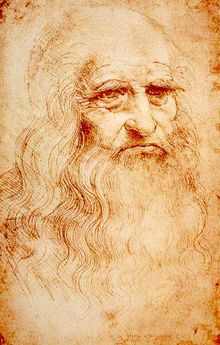
In his lifetime, Leonardo his surname is unknown, "da Vinci" means "from Vinci ” was an engineer, artist, anatomist, physiologist and much more. His full birth name was "Leonardo di ser Piero da Vinci", meaning "Leonardo, of ser Piero from Vinci". Leonardo is famous for his paintings, such as the Mona Lisaand The Last Supper, as well as for influential drawings such as the Vitruvian Man. He designed many inventions that anticipated modern technology, such as the helicopter, tank, use of solar power, the calculator, etc., though few of these designs were constructed or were feasible in his lifetime. In addition, he advanced the study of anatomy, astronomy, and civil engineering. Of his works, only a few paintings survive, together with his notebooks (scattered among various collections) containing drawings, scientific diagrams and notes.
Personal life
The first known biography of Leonardo was published in 1550 by Giorgio Vasari who wrote Vite de' piu eccelenti architettori, pittori e scultori italiani ("The lives of the most excellent Italian architects, painters and sculptors"), and later became an independent painter in Florence. Most of the information collected by Vasari was from first-hand accounts of Leonardo's contemporaries (Vasari was only a child when Leonardo died), and it remains the first reference in studying Leonardo's life.
Leonardo, the illegitimate son of a Florentine notary named Ser Piero and a local peasant woman called Caterina, was born before modern naming conventions developed in Europe; his name "Leonardo di ser Piero da Vinci", simply means "Leonardo, son of [Mes]ser Piero, from Vinci". Leonardo signed his works "Leonardo" or "Io, Leonardo" ("I, Leonardo").
Leonardo grew up with his father, Ser Piero, in Florence where he started drawing and painting. He started school when he was 5 years old. His early sketches were of such quality that his father soon showed them to the painter Andrea del Verrocchio, who subsequently took on the fourteen-year old Leonardo as an apprentice. In this role, Leonardo also worked with Lorenzo di Credi and Pietro Perugino.
But the greatest of all Andrea's pupils was Leonardo da Vinci, in whom, besides a beauty of person never sufficiently admired and a wonderful grace in all his actions, there was such a power of intellect that whatever he turned his mind to he made himself master of with ease. (see: Giorgio Vasari, The Life Of Leonardo Da Vinci (1550)
It is apparent from the works of Leonardo and his early biographers that he was a man of high integrity and very sensitive to moral issues. His respect for life led him to being a vegetarian for at least part of his life (although the term "vegan" would fit him well, as he even entertained the notion that taking milk from cows amounts to stealing. Under the heading, "Of the beasts from whom cheese is made," he answers, "the milk will be taken from the tiny children." Vasari reports a story that as a young man in Florence he often bought caged birds just to release them from captivity. He was also a respected judge on matters of beauty and elegance, particularly in the creation of pageants.
Relationships
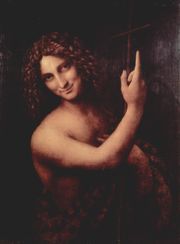
St. John the Baptist is a High Renaissance oil painting on walnut wood by Leonardo da Vinci. Probably completed from 1513 to 1516, it is believed to be his final painting. The original size of the painting was 69 x 57 cm. It is now exhibited at the Musée du Louvre in Paris, France.
The pointing gesture of St. John toward the heavens suggests the importance of salvation through baptism that John the Baptist represents.
Professional life
The earliest known dated work of Leonardo's is a drawing done in pen and ink of the Arno valley, drawn on the 5th of August, 1473. It is assumed that he had his own workshop between 1476 and 1478, receiving two orders during this time.
From around 1482 to 1499, Ludovico Sforza, Duke of Milan, employed Leonardo and permitted him to operate his own workshop, complete with apprentices. It was here that seventy tons of bronze that had been set aside for Leonardo's "Gran Cavallo" horse statue (see below) were cast into weapons for the Duke in an attempt to save Milan from the French under Charles VIII in 1495.
When the French returned under Louis XII in 1498, Milan fell without a fight, overthrowing Sforza [3]. Leonardo stayed in Milan for a time, until one morning when he found French archers using his life-size clay model of the "Gran Cavallo" for target practice. He left with Salai and his friend Luca Pacioli (the first man to describe double-entry bookkeeping) for Mantua, moving on after 2 months to Venice (where he was hired as a military engineer), then briefly returning to Florence at the end of April 1500.
In Florence he entered the services of Cesare Borgia, the son of Pope Alexander VI, acting as a military architect and engineer; with Cesare he travelled throughout Italy. In 1506 he returned to Milan, now in the hands of Maximilian Sforza after Swiss mercenaries had driven out the French.
From 1513 to 1516, he lived in Rome, where painters like Raphael and Michelangelo were active at the time, though he did not have much contact with these artists. However, he was probably of pivotal importance in the relocation of David (in Florence), one of Michelangelo's masterpieces, against the artist's will.
In 1515 Francis I of France retook Milan, and Leonardo was commissioned to make a centrepiece (a mechanical lion) for the peace talks between the French king and Pope Leo X in Bologna, where he must have first met the King. In 1516, he entered Francis' service, being given the use of the manor house Clos Lucé (also called "Cloux") next to the king's residence at the royal Chateau Amboise. The King granted Leonardo and his entourage generous pensions: the surviving document lists 1,000 écus for the artist, 400 for Melzi (named "apprentice"), and 100 for Salai ("servant"). In 1518 Salai left Leonardo and returned to Milan, where he eventually perished in a duel. Francis became a close friend.
Leonardo da Vinci died at Clos Luca, France, on 2nd May, 1519 (legend says he died in Francis's arms). According to his wish, 60 beggars followed his casket. He was buried in the Chapel of Saint-Hubert in the castle of Amboise. Although Melzi was his principal heir and executor, Salai was not forgotten; he received half of Leonardo's vineyard.
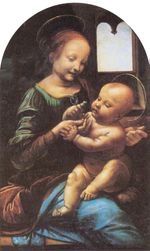
One of his first paintings done in Florence, t is likely that the Benois Madonna was the first work painted by Leonardo independently from his master Verrocchio. For centuries, Madonna and Child with Flowers was considered lost. In 1909, the architect Leon Benois sensationally exhibited it in Saint Petersburg as part of his father-in-law's collection. Since 1914 the painting has been exhibited in the Hermitage Museum in Saint Petersburg.
Art
Leonardo pioneered new painting techniques in many of his pieces. One of them, a colour shading technique called "Chiaroscuro", used a series of glazes custom-made by Leonardo. It is characterized by subtle transitions between colour areas. Another effect created by da Vinci is called sfumato, which creates an atmospheric haze or smoky effect. Chiaroscuro is a technique of bold contrast between light and dark.
Early works in Florence (1452-1482)
Leonardo was apprenticed to the artist Verrocchio in Florence when he was about 15. In 1476 Leonardo worked with Verrocchio to paint The Baptism of Christ for the friars of Vallombrosa. He painted the angel at the front and the landscape, and the difference between the two artists' work can be seen, with Leonardo's finer blending and brushwork. Giorgio Vasari told the story that when Verrochio saw Leonardo's work he was so amazed that he resolved never to touch a brush again.
Leonardo's first painting completed wholly by himself was the Madonna and Child completed in 1478; at the same time, he also painted a picture of a little boy eating sherbet. From 1480 to 1481, he created a small Annunciation painting, now in the Louvre. In 1481 he also painted an unfinished work of St. Jerome. Between 1481 and 1482 he started painting The Adoration of the Kings (also known as The Adoration of the Magi). He made extensive, ambitious plans and many drawings for the painting, but it was never finished, as Leonardo's services had been accepted by the Duke of Milan, to where he traveled.
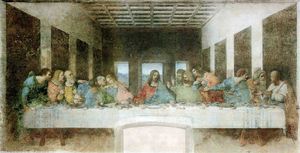
Leonardo spent 17 years in Milan in the service of Duke Ludovico (between 1482 and 1499). He did many paintings, sculptures, and drawings during this time. He also designed court festivals, and drew many of his engineering sketches. He was given free reign to work on any project he chose, though he left many projects unfinished, completing only about six paintings during this time. These include The Last Supper(Ultima Cena or Cenacolo, in Milan) in 1498 and Virgin of the Rocks in 1494. In 1499 he painted Madonna and Child with St. Anne. He worked on many of his notebooks between 1490 and 1495.
He often planned grandiose paintings with many drawings and sketches, only to leave them unfinished. One of his projects involved making plans and models for a monumental seven-metre-high (24 ft) horse statue in bronze called "Gran Cavallo". Because of war with France, the project was never finished. (In 1999 a pair of full-scale statues based on his plans were cast, one erected in Grand Rapids, Michigan, the other in Milan.) The bronze intended for use in the building of the statue was used to make cannon, and victorious French soldiers used the clay model of the statue for target practice. The Hunt Museum in Limerick, Ireland has a small bronze horse thought to be the work of an apprentice from Leonardo's original design.
When the French invaded Milan in 1499, Ludovico Sforza lost control, forcing Leonardo to search for a new patron.
Nomadic Period - Italy and France (1499-1519)
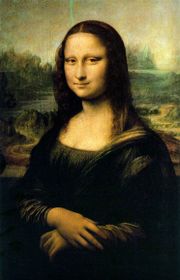
Mona Lisa (1503-1507)
Between 1499 and 1516 Leonardo worked for a number of people, travelling around Italy doing several commissions, before moving to France in 1516. This has been described as a 'Nomadic Period'. [5] He stayed in:
- Mantua (1500)
- Venice (1501)
- Florence (1501-06) known sometimes as his Second Florentine Period.
- Travelled between Florence and Milan staying in both places for short periods before settling in Milan.
- Milan (1506-13) (known sometimes as his Second Milanese Period, under the patronage of Charles d'Amboise until 1511)
- Rome (1514)
- Florence (1514)
- Pavia, Bologna, Milan (1515)
- France (1516-19) (patronage of King Francis I)
In 1500 he went to Mantua where he sketched a portrait of the Marchesa Isabella d'Este. He left for Venice in 1501, and soon after returned to Florence.
After returning to Florence, he was commissioned for a large public mural commemorating a great military triumph in the history of Florence, by the Grand Council Chamber in the Palazzo Vecchio, the seat of government of the Florentine Republic (Zollner p. 164), The Battle of Anghiari; his rival Michelangelo was to paint the opposite wall. After producing a fantastic variety of studies in preparation for the work, he left the city, with the mural unfinished due to problems with getting paid by his employer and more importantly by his choice of technique, which instead of the fresco technique he experimented again (as in the last supper) with oil binders hoping to extend the time to manipulate the paint (Complete Works of Da Vinci Zollner p172-178). The incomplete painting was destroyed in a war in the middle of the sixteenth century.
Most evidence proves that he began work on the Mona Lisa (also known as La Gioconda, now at the Louvre in Paris) in 1503 and continued to work on it until 1506, working sporadically on it well after that ( Sasson p 22). It is likely to be Lisa de Gherardini del Giocondo, wife of a silk merchant, Francesco del Giocondo. Commissioned by her husband to commemorate the birth of their second son as well as moving to a new home (zollner p240). He most likely kept it with him at all times, and did not travel without it. Much is attributed to the importance of this painting, primarily why it is the most famous painting in the world. In short, it was famous at the time of its contemporaries for many different reasons than it is now. Leonardo Da Vinci's use of sfumato (the smoky effect he has on his work) transcended convention of the time, as did the sitter's angle, contrapposto, and the birds eye view of the background. For the most part it has become famous for all of the above and for the insurmountable amount of media attention it has received, in other words, it has become famous for being famous.
He painted St Anne in 1509. Between 1506 and 1512, he lived in Milan and under the patronage of the French Governor Charles d'Amboise, he painted several other paintings. These included The Leda and the Swan, known now only through copies as the original work did not survive. He painted a second version of The Virgin of the Rocks (1506-1508). While under the patronage of Pope Leo X, he painted St. John the Baptist (1513-1516).
During his time in France, Leonardo made studies of the Virgin Mary for The Virgin and Child with St. Anne, and many drawings and other studies.
Selected works
- The Baptism of Christ (1472-1475) Uffizi, Florence, Italy (from Verrocchio's workshop; angel on the left-hand side is generally agreed to be the earliest surviving painted work by Leonardo)
- Annunciation (1475-1480) Uffizi, Florence, Italy
- Ginevra de' Benci (c. 1475) National Gallery of Art, Washington, D.C., United States
- The Benois Madonna (1478-1480) Hermitage Museum, Saint Petersburg, Russia
- The Virgin with Flowers (1478-1481) Alte Pinakothek, Munich, Germany
- Adoration of the Magi (1481) Uffizi, Florence, Italy
- >The Madonna of the Rocks (1483-86) Louvre, Paris, France
- Lady with an Ermine (1488-90) Czartoryski Museum, Krakow, Poland
- >Portrait of a Musician (c. 1490) Pinacoteca Ambrosiana, Milan, Italy
- Madonna Litta (1490-91) Hermitage Museum, Saint Petersburg, Russia
- La belle Ferronière (1495-1498) Louvre, Paris, France
- Last Supper (1498) Convent of Sta. Maria delle Grazie, Milan, Italy
- The Virgin and Child with St. Anne and St. John the Baptist (c. 1499-1500) National Gallery, London, UK
- Madonna of the Yarnwinder 1501 (original now lost)
- Mona Lisa or La Gioconda (1503-1505/1507) Louvre, Paris, France
- The Madonna of the Rocks or The Virgin of the Rocks (1508) National Gallery, London, UK
- Leda and the Swan (1508) - (Only copies survive best-known example in Galleria Borghese, Rome, Italy)
- The Virgin and Child with St. Anne (c. 1510) Louvre, Paris, France
- St. John the Baptist (c. 1514) Louvre, Paris, France
- Bacchus (or St. John in the Wilderness) (1515) Louvre, Paris, France

The rhombicuboctahedron, by Leonardo, as it appeared in the Luca Pacioli's Divina Proportione, 1509.
Science and engineering
Renaissance humanism saw no mutually exclusive polarities between the sciences and the arts, and his studies in science and engineering are as impressive and innovative as Leonardo's artistic work, recorded in notebooks comprising some 13,000 pages of notes and drawings, which fuse art and science. These notes were made and maintained through Leonardo's travels through Europe, during which he made continual observations of the world around him. He was left-handed and used mirror writing throughout his life. This is explainable by the fact that it is easier to pull a quill pen than to push it; by using mirror-writing, the left-handed writer is able to pull the pen from right to left. He wrote his diaries (journals) using mirror writing.
His approach to science was an observational one: he tried to understand a phenomenon by describing and depicting it in utmost detail, and did not emphasize experiments or theoretical explanations. Throughout his life, he planned a grand encyclopedia based on detailed drawings of everything. Since he lacked formal education in Latin and mathematics, contemporary scholars mostly ignored Leonardo the scientist.
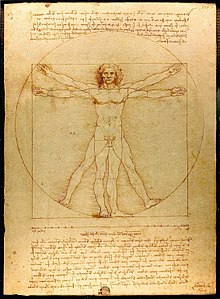
Da-Vinci-Vitruve-Luc-Viatour
Anatomy
Leonardo started to discover the anatomy of the human body at the time he was apprenticed to Andrea del Verrocchio, as his teacher insisted that all his pupils learn anatomy. As he became successful as an artist, he was given permission to dissect human corpses at the hospital Santa Maria Nuova in Florence. Later he dissected also in Milano in the hospital Maggiore and in Rome in the hospital Santo Spirito (the first mainland Italian hospital). From 1510 to 1511 he collaborated with the doctor Marcantonio della Torre (1481 to 1511). In 30 years, Leonardo dissected 30 male and female corpses of different ages. Together with Marcantonio, he prepared to publish a theoretical work on anatomy and made more than 200 drawings. However, his book was published only in 1580 (long after his death) under the heading Treatise on painting.
Leonardo drew many images of the human skeleton, and was the first to describe the double S form of the backbone. He also studied the inclination of pelvis and sacrum and stressed that sacrum was not uniform, but composed of five vertebrae. He was also able to represent exceptionally well the human skull and cross-sections of the brain (transversal, sagittal, and frontal). He drew many images of the lungs, mesentery, urinary tract, sex organs, and even coitus. He was one of the first who drew the fetus in the intrauterine position (he wished to learn about "the miracle of pregnancy"). He often drew muscles and tendons of the cervical muscles and of the shoulder. He was a master of topographic anatomy. He not only studied the anatomy of human, but also of other beings. It is important to note that he was not only interested in structure but also in function, so he was an anatomist and physiologist at the same time. Because he actively searched for bodily deformed people to paint them, he is also considered to be the beginner of caricature.
His study of human anatomy led also to the design of the first known robot in recorded history. The design, which has come to be called Leonardo's robot, was probably made around the year 1495 but was rediscovered only in the 1950s. It is not known if an attempt was made to build the device. He correctly worked out how heart valves eddy the flow of blood yet he was unaware of circulation as he believed that blood was pumped to the muscles where it was consumed. A diagram drawing Leonardo did of a heart inspired a British heart surgeon to pioneer a new way to repair damaged hearts in 2005. [6]
Inventions and engineering
Fascinated by the phenomenon of flight, Leonardo produced detailed studies of the flight of birds, and plans for several flying machines, including a helicopter powered by four men (which would not have worked since the body of the craft would have rotated) and a light hang glider which could have flown.1 On January 3, 1496 he unsuccessfully tested a flying machine he had constructed.
In 1502 Leonardo da Vinci produced a drawing of a single span 720-foot (240 m) bridge as part of a civil engineering project for Sultan Beyazid II of Constantinople. The bridge was intended to span an inlet at the mouth of the Bosphorus known as the Golden Horn. It was never built, but Leonardo's vision was resurrected in 2001 when a smaller bridge based on his design was constructed in Norway.
Owing to his employment as a military engineer, his notebooks also contain several designs for military machines: machine guns, an armoured tank powered by humans or horses, cluster bombs, a working parachute, etc. even though he later held war to be the worst of human activities. Other inventions include a submarine, a cog-wheeled device that has been interpreted as the first mechanical calculator, and a car powered by a spring mechanism. In his years in the Vatican, he planned an industrial use of solar power, by employing concave mirrors to heat water. While most of Leonardo's inventions were not built during his lifetime, models of many of them have been constructed with the support of IBM and are on display at the Leonardo da Vinci Museum at the Chateau du Clos Luc in Amboise.
His notebooks
Leonardo's notebooks were on four main themes; architecture, elements of mechanics, painting, and human anatomy. These notebooks - originally loose papers of different types and sizes, distributed by friends after his death - have found their way into major collections such as the Louvre, the Biblioteca Nacional de España, the Biblioteca Ambrosiana in Milan, and the British Library. The British Library has put a selection from its notebook (BL Arundel MS 263) on the web in the Turning the Pages section. The Codex Leicester is the only major scientific work of Leonardo's in private hands. It is owned by Bill Gates, and is displayed once a year in different cities around the world.
Why Leonardo did not publish or otherwise distribute the contents of his notebooks remains a mystery to those who believe that Leonardo wanted to make his observations public knowledge. Technological historian Lewis Mumford suggests that Leonardo kept notebooks as a private journal, intentionally censoring his work from those who might irresponsibly use it (the tank, for instance). They remained obscure until the 19th century, and were not directly of value to the development of science and technology. In January 2005, researchers discovered the hidden laboratory used by Leonardo da Vinci for studies of flight and other pioneering scientific work in previously sealed rooms at a monastery next to the Basilica of the Santissima Annunziata, in the heart of Florence.
In fiction
With the genius and legacy of Leonardo da Vinci having captivated authors and scholars generations after his death, many examples of "Da Vinci fiction" can be found in culture and literature. Such an example is "The Da Vinci Code" by Dan Brown, published 2003.
Leonard of Quirm, a character in the Discworld series of novels, is based largely on Leonardo Da Vinci.
More Great Thinkers Great Minds
- Marie Curie
- Pablo Picasso
- Edwin Hubble
- Jean Piaget
- Robert Boyle
- Plato
- Rene Descartes
- Miguel de Cervantes
- Friedrich Nietzsche
- Michelangelo Buonarroti
- Gary Kasparov
- Galileo Galilei
- Dmitri Mendeleev
- Archimedes
- Albert Einstein
- Isaac Newton
- Leonhard Euler
- Enrico Fermi
- Joseph Louis Lagrange
- Carl Friedrich Gauss
- Bernhardt Riemann
- Kurt Gödel
- William Shakespeare
- Betrand Russell
- Charles Darwin
- Fyodor Dostoevsky
- Leo Tolstoy
- Niels Bohr
- Linus Pauling
- Leonardo Da Vinci
- Blaise Pascal
- Michael Faraday
- James Clerk Maxwell
- Aristotle
- Alan Turing
- Sigmund Freud
- Gottfried Leibniz
- Max Planck
- Aleksandr Pushkin
- Ivan Pavlov
- Pierre de Fermat
- Johann Wolfgang von Goethe
- Steven Hawking
- Steve Jobs
